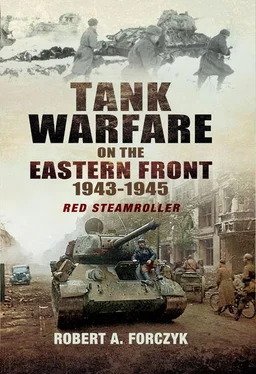Hoth’s Stand on the Manych River, 1–31 January 1943
At the start of January 1943, Generalfeldmarschall Erich von Manstein’s Heeresgruppe Don was in retreat and barely able to hold a coherent front. Manstein’s strongest formation was Generaloberst Hermann Hoth’s 4.Panzerarmee (PzAOK 4), which consisted merely of the LVII Panzerkorps, part of a Luftwaffe field division and the remnants of the Romanian 4th Army. Nevertheless, General der Panzertruppe Friedrich Kirchner’s LVII Panzerkorps possessed the 17. and 23.Panzer-Divisionen, the 16.Infanterie-Division (mot.) and Sturmgeschütz-Abteilung 203 and SS-Panzergrenadier-Division Wiking was just arriving from the Terek River front; altogether Kirchner’s corps had fewer than 100 tanks and assault guns still operational. Having abandoned the Stalingrad relief effort, Hoth’s Panzerarmee had retreated more than 100km down the Tikhoretsk-Stalingrad rail line toward the Manych River in the last half of December, pursued by General-polkovnik Andrei I. Eremenko’s Southern Front. Manstein’s other major formation was Gruppe Hollidt, which consisted of General der Panzertruppe Otto von Knobelsdorff’s XXXXVIII Panzerkorps, the XVII and XXIX Armeekorps and Korps Mieth. General der Infanterie Karl A. Hollidt’s ramshackle command had the 6., 11. and 22.Panzer-Divisionen assigned, with roughly 90 operational tanks and assault guns, as well parts of four infantry and two Luftwaffe field divisions. Hollidt’s forces were in the process of retreating from the Chir River, pursued by General-polkovnik Nikolai F. Vatutin’s Southwest Front.
LVII Panzerkorps stand north of the Manych River, 5–11 January 1943.
Manstein’s situation was grim, but he was about to receive some significant reinforcements in the shape of the rebuilt 7.Panzer-Division (156 tanks) just arriving from France and 2./s. Panzer-Abteilung 502 and 1., 2./s. Panzer-Abteilung 503 inbound with a total of 29 Tiger tanks and 35 Pz III Ausf N tanks. Obviously, German doctrine dictated that committing all these reinforcements in one sector would yield the most decisive results, but von Manstein was in a dilemma since he was facing crises in both Hollidt’s and Hoth’s sectors. He decided to split the reinforcements, sending all the Tigers to assist Hoth and 7.Panzer-Division to assist Hollidt.
By New Year’s day, the first Tiger tanks were unloading at the rail station at Proletarskaya, just north of the Manych River. At that point, Kirchner’s LVII Panzerkorps had established a thin screen with 17. and 23.Panzer-Divisionen and a Kampfgruppe from 16.Infanterie-Division (mot.) 75km to the northeast near Zimovniki, where 4.Panzerarmee quartermasters had established a supply dump. Although the rail line to Zimovniki was not really secure, some trains with replacement tanks and vehicles for Kirchner’s corps were allowed to proceed there. The SS- Wiking Division was also detraining at Proletarskaya after its transfer from Heeresgruppe A; a single motorized battalion from SS-Panzergrenadier-Regiment Westland was moving rapidly up the road to Zimovniki, but the rest of the division was lagging well to the rear. Kirchner’s forces were spread very thinly and their eastern flank was relatively open due to the disintegration of the Romanian 4th Army. Amazingly, only rear area troops were actually in Zimovniki when Soviet tanks appeared on the morning of 1 January.
Eremenko was advancing toward Proletarskaya with General-leytenant Rodion Ia. Malinovsky’s powerful 2nd Guards Army and General-major Nikolai I. Trufanov’s 51st Army, which altogether had two tank and three mechanized corps. Although Eremenko’s armour was depleted after the heavy fighting since the beginning of Operation Uranus on 19 November 1942, he likely still had at least 300–400 operational tanks. Out in front was General-major Trofim I. Tanaschishin’s 13th Tank Corps, approaching Zimovniki from the northeast. Tanaschishin was a veteran tanker who had been commanding armour units since the 1930s and he recognized that Hoth’s frontline was fluid, so he decided to launch an immediate assault upon Zimovniki. Around 0830 hours, six tanks and a battalion of motorized infantry pushed into the northeastern corner of the town, catching the Germans completely by surprise. In panic, staff officers believed this handful of tanks to be the vanguard of Eremenko’s host and ordered all stores and equipment at the rail station destroyed, including 47,000 winter uniforms and new tanks that had just arrived. All damaged vehicles in the repair units were also set on fire. {14} However, the Soviet incursion was just a raid and SS-Panzergrenadier-Regiment Westland arrived in time to prevent the fall of the entire town and evicted Tanaschishin’s raiding force. The SS panzergrenadiers quickly established a coherent defensive hedgehog in the town, but their tanks were well to the rear and 17.Panzer-Division was covering their western flank out to the Sal River. It is important to note that the German panzer units were forced to spread their tanks around to cover a large sector, depriving them of mass and violating their accepted doctrine of concentration.
It took Eremenko a few days to bring up the rest of his two armies, but on 3 January he sent the 2nd Guards Mechanized Corps and 3rd Guards Tank Corps against the 17. Panzer-Division, while the 6th Mechanized Corps reinforced Tanaschishin for an assault upon Zimovniki. General-major Aleksei P. Sharagin’s 3rd Guards Mechanized Corps was sent to envelop Wiking’s eastern flank, forcing them to extend their front. Although the 17. Panzer-Division managed to destroy about 17 Soviet tanks, Kirchner was forced to refuse both his left and right flanks to prevent from being encircled. Reinforced by part of the SS-Panzergrenadier-Regiment Germania , the Wiking managed to hold Zimovniki until 7 January when mounting pressure on both flanks forced Kirchner to retreat 25-km south to Kuberle. It was at Kuberle that SS-Sturmbannführer Johannes-Rudolf Mühlenkamp’s SS-Panzer-Abteilung 5 finally arrived. Yet no sooner had Mühlenkamp’s panzers driven into Kuberle than the SS- Wiking Division received a report that Soviet infantry had cut the rail line behind them at Orlivskiy. Although the 23. Panzer-Division was supposed to be screening the area east of the rail line to Proletarskaya, its positions were so thinly spread that they had failed to detect a battalion of Sharagin’s 3rd Guards Mechanized Corps getting around behind the SS- Wiking Division. When the Soviet infantry entered Orlivskiy on the morning of 8 January there were only rear-echelon troops there and they quickly retreated, leaving the Soviets in control of half the town. Mühlenkamp’s panzers were immediately ordered back to Orlivskiy to clear the Soviet raiding party but by the time that they arrived, a local counter-attack by an engineer unit had chased off the Soviets; the SS tankers were then ordered to drive back to Kuberle – an exhausting back-and-forth effort that exhausted both men and tanks. On the icy roads in the dark, the panzers were only capable of making 3–4km/hour, which meant that Mühlenkamp’s panzers spent over 24 hours driving to and fro to no purpose.
Meanwhile, the main body of Sharagin’s 3rd Guards Mechanized Corps (3GMC) advanced westward along the north side of the Manych, heading for Proletarskaya. Sharagin’s corps had only been in action for two weeks and was close to full strength, although it did not have sufficient trucks for its nine infantry battalions. Despite frequent snow showers, Luftwaffe reconnaissance spotted Sharagin’s forces 40km east of Proletarskaya and alerted Generalmajor Nikolaus von Vormann, who had just taken command of the 23. Panzer-Division. This Panzer-Division was in exceedingly poor condition, having just 19 operational tanks in Panzer-Regiment 201 and 4 SPW in the I./Panzergrenadier-Regiment 128. {15} Indeed, the division was so short of infantry that it had been forced to create two ad hoc infantry companies from dismounted tankers. Ammunition and fuel stocks were extremely low. Nevertheless, von Vormann realized that his forces were too weak to defend against a full-strength Soviet mechanized corps, so he opted to attack instead. Both Tiger companies from s. Panzer-Abteilung 503 were attached to von Vormann’s division. The other Tiger company, 2./s. Pz.-Abt. 502 was sent north to Kuberle to assist the 17. Panzer-Division’s rearguard. {16}
Читать дальше








![John Stieber - Against the Odds - Survival on the Russian Front 1944-1945 [2nd Edition]](/books/405234/john-stieber-against-the-odds-survival-on-the-russian-front-1944-1945-2nd-edition-thumb.webp)



